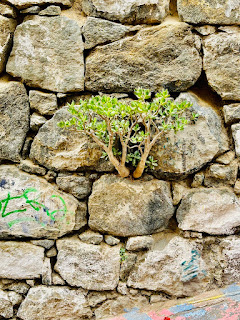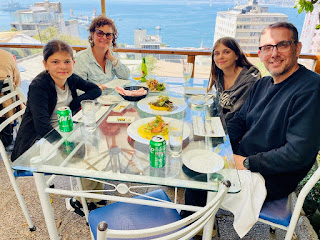
Our boutique hotel in Valparaíso - only for hours, before we left it because of the forest fire alarm and the Alpaca blanket allergies.
Maybe the Valpo Granma wasn't happy to have us there. :)
The Plaza Sotomayor is a plaza in Valparaíso, Chile. It is named after Rafael Sotomayor. The square is lined by buildings occupying full block-fronts of the streets that flank it. The focus of the square is the monument that honors the Chilean sailors who fell during the Battle of Iquique and the Battle of Punta Gruesa. The plaza and surrounding buildings was designated a Zona Típica (historic district) on January 23, 1979.
At the northeastern side of the square are two similar towers, which create a sort of gate entrance to the port from the city. On the opposite side is the building that housed the Intendencia de Valparaíso, which currently is home to the headquarters of the Chilean Navy. The building used by the CSAV and the building that houses the National Council of Culture and the Arts also face the plaza.
Close to the station is the western terminus station of the Valparaíso Metro, that replaced the old railway station.
This man - who gave me permission to photograph him - haunts me in a pleasant way.
Every line of his face and hands make me wonder of the history he carries.

The feeling I have here is that time has stop about 40 years ago. The clothes, the hair styles, the pace of living, people's behaviour. This photo captures a travel in time while being in real time.
Because of the slopes of the hills, many of the surrounding areas of Valparaíso are inaccessible by public transport. That is why "elevators" serve the function of communicating the high part of the city with the plan, besides being a strong holiday highlight. The only elevator that can truly be called as such, is the Ascensor Polanco, because it is vertical. Meanwhile, the rest are cable cars but traditionally called elevators. Several of those funiculars – locally called ascensores – provide public transport service between the central area and the lower slopes of the surrounding hills, the first of which (Ascensor Concepción, also known as Ascensor Turri) opened in 1883, operated by steam, is still in service.The Cerro Cordillera elevator was built in 1887. As many as 28 different funicular railways have served Valparaíso at one time or another, of which 14 were still in operation in 1992 and still around 12 in 2010.
Valparaíso has fifteen lifts declared Historical Monuments by the National Monuments Council. Five are municipal property and the remaining belong to four private companies. The elevators are elevators municipal Baron, El Peral, Polanco, Queen Victoria and St. Augustine. As for the rest, lifts Florida, Butterflies and Nuns are owned by the National Elevator Company SA; Artillery, Concepción and Mountains belong to the Society of Mechanical Lifts Valparaíso Holy Spirit, Larraín and Villaseca (stopped for repairs) are the property of Valparaíso Elevators Company SA, and Dairy (stopped by fire) belongs to the Society of Dairy Cerro Lifts Ltd.
As a part of its 2003 declaration as a UNESCO World Heritage Site, Valparaíso has promised to replace and maintain its several funiculars. The funiculars were identified as an important cultural artifact.
Look at this building... an Yugoslavian architecture. Germans, British, Spanish, they all had their contribution to this eclectic mosaic.


The tour was over and our bellies were empty.
We stopped for lunch at this fancy restaurant with a view called La Concepción.
It was an opportunity to try a local beer from... Curacavi, the small town we stopped for lunch yesterday!
Ceviche recipes vary by region. Peru claims the origin of the dish to be nearly 2000 years ago in Lima.
Sea lions, pelicans and the sparkling ocean make this a worthwhile addition to your list of things to do in Valparaiso Chile. At Caleta Portales the sea lions fight each other to sunbathe on a large concrete structure just offshore. Watching them argue and try to jump up onto the platform is a lovely way to spend some time on a summer’s day.
Walk: If you have time, walk the 2 km to get to Caleta Portales
Metro: Take the Metro from the stations Puerto or Bellavista and get off at Baron. From there cross the tracks.

Even when it looks like they are fighting, it is hilarious to watch them falling back into the water.
They were good, but when in Chile...






































No comments:
Post a Comment